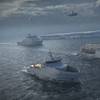NAVSEA Releases Fire Safety Manual
Naval Sea Systems Command (NAVSEA) released a new fire safety and prevention manual for all ship repair and construction activities, Feb. 6.
The manual integrates existing shipboard fire safety requirements with lessons learned from the major fire that occurred on board USS Miami (SSN 755) at Portsmouth Naval Shipyard in 2012.
It was developed and reviewed by industrial and fire safety experts across the Navy and provides a single source requirements document to improve shipboard fire safety during industrial work. It applies to all public and private ship construction and repair activities, and to all ship availabilities.
"Navy leadership recognized a clear need to raise our standards and capabilities, and develop cost-effective solutions to improve fire prevention, detection, immediate response and extended response for ships undergoing industrial maintenance," said Vice Adm. William Hilarides, NAVSEA commander.
The manual provides policy on how to deal with hot work during an industrial availability, handling of flammable and combustible materials, and fire prevention and safety inspections. The manual also requires the installation of a temporary automatic fire detection system during submarine availabilities.
Every ship repair and construction activity will be required to perform an annual fire drill to test its full fire response plan and emergency response capability. These drills will provide a forum for each activity to prove their local plan is effective.
"This manual is the right long-term response to the watershed event the Miami fire represents," said Hilarides. "It is imperative that all organizations implement the applicable requirements of this manual and ensure their fire safety and response procedures and capabilities are solid."
However, it is equally important that the shipyards and maintenance activities implement the requirements judiciously. Since the manual covers all ship availabilities, it provides tiered risk mitigations based on the amount and complexity of the work being performed, and provides the flexibility to address unique and challenging situations. Commands are empowered to address these considerations and determine how to apply the requirements for each ship availability.
"I expect thoughtful consideration by the naval shipyards, Regional Maintenance Centers, Trident refit facilities, fleet maintenance activities, private repair shipyards, new construction shipyards and ships in determining how to apply the requirements for each availability, " said Hilarides. "Organizations are expected to be judicious and make smart decisions to achieve an optimum balance of all the risks - fire safety, as well as cost and schedule."
NAVSEA, the largest of the Navy's systems commands, is comprised of more than 58,000 civilian and military personnel in 36 activities located across the United States and around the world. Together, these men and women are charged with developing, delivering and maintaining ships and systems on time, on cost for the U.S. Navy.
navy.mil










